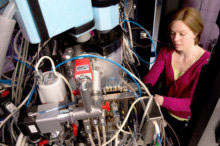Electron Microscopy

The LMB has an outstanding Electron Microscopy (EM) Facility with a focus on electron cryo-microscopy (cryoEM) of unstained biological materials.

Since 1962, EM has been an important tool for life sciences research at the LMB. The LMB was among the first laboratories worldwide to apply EM techniques for research aimed at understanding the structural basis of important life processes and the pathogenesis of disease. The LMB was also one of the first labs to adopt cryoEM for studying biomolecular structures. Recent breakthroughs in the LMB, including the development of direct electron detectors (e.g. Falcon), image-processing software (e.g. MRC, Relion) and specimen preparation techniques (e.g. UltrAuFoil® and partially hydrogenated graphene support films), have been a powerful driving force for the rapid development of cryoEM. The dramatic improvement in data quality and computer-assisted image processing have led to a “resolution revolution” in structural biology studies by cryoEM. The result is that scientists in the LMB and around the world are now able to obtain structures at near atomic resolution, and of more specimens, than was previously possible.
Powered by biological questions and technical developments, the LMB EM Facility is continuously expanding and improving in instrumentation and application. Currently the facility has eleven EMs available, including five 300kV FEG Transmission EMs (TEM) (three Titan-Krios and two Polara G2s, with Falcon III & IV electron counting, K2 and K3 detectors and Quantum energy-filters); two 200kV FEG TEMs (Glacios and Tecnai F20); two 120 kV TEMs; one Scios Cryo-FIB-SEM and one desk-top SEM with EDS. The EM Facility provides specimen screening and automatic high-resolution cryoEM data collection with a wide range of applications including single-particle analysis (SPA), cryo-tomography (cryoET), and spectroscopy application (STEM, EELS). Equipment for high pressure freezing and cryo-microtomy, and cryo-substitution, embedding and room temperature sectioning are also available, allowing cryoET analysis of vitreous sections or STEM tomography for bulk specimens. The Scios cryo-FIB-SEM is equipped with Quorum cryo system for preparation of cellular lamella for cryoET.
The EM Facility has a full-range of specimen preparation devices including three Vitrobots, two manual plungers, two plasma machines, three vacuum evaporators, and three glow-dischargers. The microscope data servers are connected to the central computing facility of the LMB which provides capacity for EM data storage and a wide range of software including Relion, MRC software, EMAN, SPIDER, IMAGIC, CryoSPARC, IMOD etc and high-speed processing cores including GPU cores for data processing, analysis and presentation. The EM Facility is primarily intended for hands-on research by students, postdocs and group leaders, who prepare specimens, operate the EMs and analyse the resulting images or diffraction patterns themselves. Full training or assisted cryoEM data collection are provided by the facility staff. The LMB runs a regular cryoEM course and further details can be found on the Scientific Training pages.
In addition to the in-house equipment, members of the LMB are part of the national and international electron microscopy community and have access to additional equipment in the National Facility (eBIC at Diamond Light Source, Oxford) and other cryoEM facilities around the world.
The EM facility is headed by Shaoxia Chen.